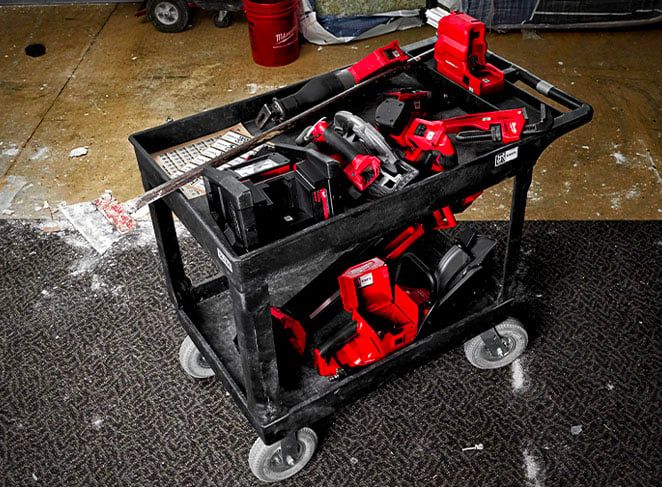That said, what hasn’t changed, nor will it, is our commitment to help you keep your crew safe. Our team is here to help you and your crew in any capacity.
-
Below is list of tool sanitation practices recommended by the Center for Disease Control (“CDC”), OSHA, and State and Local health departments. Following these guidelines can help you contribute to curbing the spread of coronavirus.
-
If you have ceased operations, we’ve also added a few inventory management tips to secure your closed jobsites.
General Guidelines
-
When handling tools, you should wash your hands or use proper hand sanitizer before and after to prevent contamination.
-
Anyone handling tools should be properly trained and protected using Personal Protective Equipment (PPE).
-
Tools should be cleaned with mild soap, a clean damp cloth, and, as needed, an approved diluted bleach solution only.
-
Cleaners that have conductive or corrosive materials, especially those with ammonia, should not be used. Some household detergents contain ammonia, for example, so you should read the ingredients carefully. Other examples of conductive or corrosive materials to avoid include: gasoline, turpentine, lacquer thinner, paint thinner, and chlorinated cleaning solutions.
Cleaning Options
1. Mild Soap & Rest
-
If you assess there’s no blood on the product, it can be cleaned with mild soap and a damp cloth to remove fluids and then left to rest for 3 days. This is based on CDC advisement that the virus may live on plastic surfaces for up to 72 hours, which also suggests that the virus would no longer be harmful after the resting period. After this, the tool can be used again.
-
Recommended for batteries. Do not allow fluid to flow into the battery. Mild Soap & Diluted Bleach Solution
-
If you assess there’s no blood on the product, it can be cleaned with a mild soap and damp cloth to remove dirt and greased and then decontaminated with a diluted bleach solution, which is consistent with CDC advice. The full diluted procedure can be found below.
-
Note: Not for batteries
Procedure
-
Clean the product surface with mild soap and water to remove dirt and grease.
-
Dip a clean cloth into the dilute bleach solution.
-
Wring out the cloth so it is not dripping wet.
-
Gently wipe each handle, grasping surfaces, or outer surfaces, with the cloth. Use care to ensure liquids do not flow into the tool.
-
No other cleaning material should be used as the diluted bleach solution should never be mixed with ammonia or any other cleanser.
-
Allow the surface to dry naturally.
-
You should avoid touching your face with unwashed hands and immediately wash your hands after this process.
A properly diluted bleach solution can be made by mixing:
-
5 tablespoons (1/3rd cup) bleach per gallon of water, or
-
4 tablespoons bleach per quart of water
NOTE: If blood was on the product, advance cleaning is needed. Follow established Bloodborne Pathogen protocols for your business. Under OSHA requirements, anyone required to perform this type of cleaning should be trained in Bloodborne Pathogens and use the necessary PPE for this work.
Some Ideas for What to Do When Ceasing Operations May Be Necessary
Nobody likes having to close up shop. But in the face of coronavirus, it’s a necessary step in helping to keep ourselves healthy and safe. Here are a couple ideas of what you can do for your tools while sheltering-in-place may be necessary.
Take Care of Tool and Equipment Maintenance
If you’re quarantined at home and are fortunate enough to have tools with you, this is a great time to take care of some of your tool maintenance needs. Doing this is a necessary part in ensuring the health and longevity of your tools and equipment.
Here are some ideas:
- Clean and lubricate internal and external components in accordance with their owner's manuals and recommended care instructions
- Send equipment out for calibration or scheduled maintenance
- Replace worn out parts in accordance with their owner's manual and care instructions
- Inspect for water damage
Additionally, you can find manufacturer-specific recommendations for tool maintenance and equipment management in your owner’s manual. You’ll also find the manufacturer-recommended service schedule here.
One-Key automatically uploads your owner’s manual for Milwaukee® tools when you add them to inventory by serial number. You can access a PDF document of your owner’s manual by navigating to “uploads” within the item’s details.
If you’re due for service, what better time than now to get this work done? This will make sure that your tools and equipment are in tip-top shape and performing to specification when sent to jobs once you’re back up and running.
Make sure you uphold your warranty by sending your tools and equipment to one of our approved Milwaukee service centers.
Secure Tools and Equipment Remotely
If you are an equipment manager that finds you’ve had to shut down operations, we recommend locking out your One-Key compatible tools.
One-Key compatible tools are built standard with Milwaukee tool security features that can:
-
prevent tampering and discourage theft by making tools non-operational.
-
prevent potential hazards when equipment is left behind.
A Message from the One-Key Team: Stay Safe!
With COVID-19, we’re all currently in an uncertain time. But if we follow the recommended safety protocols, we can all, together, help flatten the curve! We’ll be here to help you with any of your One-Key system-related needs.




